In October 2015, I had the exciting opportunity to talk about common AdWords mistakes in Bangkok for DCBKK. You can view the slide deck on our SlideShare. Even though this was a couple of years ago, the topics in this post still hold true in 2018. One of the biggest problems eCommerce businesses have is avoiding wasted spend for their ads.
One of the most common PPC mistakes is “being asleep at the wheel“. It illustrates an all-too-common PPC pitfall that I see experienced account managers make.
There is an epidemic of wasted, unprofitable spend in any account. It’s difficult to stay vigilant on 1,000’s of keywords, 10’s of 1,000’s of negative keywords, all 168 hours each week, hundreds of products, and multiple channels.
The goal of this post is to help you prevent and find unprofitable areas of your AdWords account the moment it happens. Finding wasted spend in your account as-it-happens can save you hundreds (thousands for larger campaigns) every week.
First, let’s talk about how to find the wasted spend in your AdWords campaign.
HOW TO FIND ALL THE WASTED SPEND IN YOUR ADWORDS ACCOUNT
Step 1: Turn on a Filter
Go to the keyword tab, and click “filter”. Create a filter to show you all keywords with zero conversions. Image below:
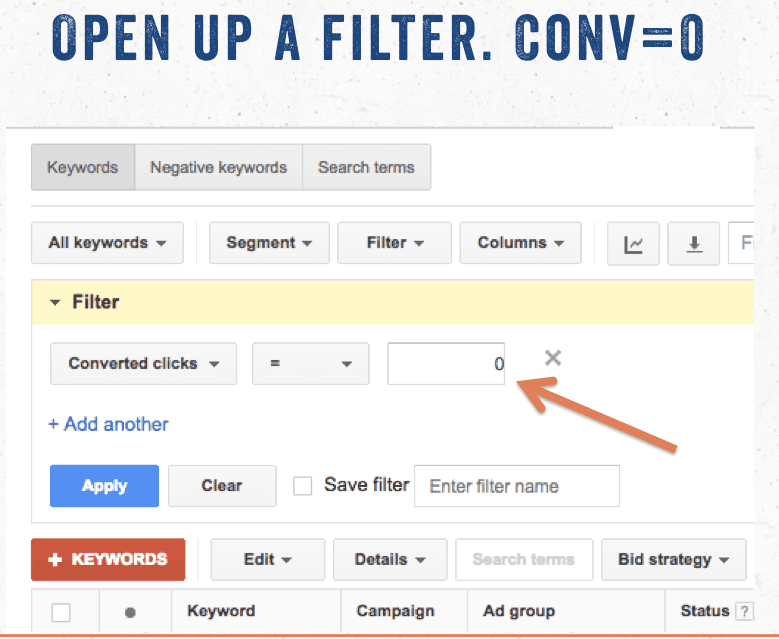
Step 2: Run for the Hills!
If your account hasn’t been properly managed, you may see something like this.
Ouch. The truth hurts.
OVERSPENDING HAPPENS ALL THE TIME
If you think this is an uncommon occurrence, think again. Whenever I audit an account, this is one of the first places I look, and it is strikingly common.
And it’s not just items with zero conversions.
What about a website changing its URL’s – and now the traffic is being sent to a 404 page. Your quality scores will tank, and you’ll waste tons of money.
WHY IS THERE SO MUCH WASTED SPEND ON ADWORDS?
I’ve talked before about how people can waste spend using broad match keywords. This is a little more nuanced than a simple keyword match type.
Let’s take a pretty normal situation:
A small business hires Jamie, the freelancer. Jamie is great, and she’s managing just a small handful of PPC clients–5 in total. Jamie crosses her T’s and dots her I’s whenever she can. She adds plenty of negative keywords and tries to keep conversions high. Things are going great, and her account is now growing.
What was once a small account of maybe 100 keywords, is now a massive account with 10 different kinds of campaigns. She’s got search campaigns, display campaigns, RLSA campaigns, product listing ad campaigns, and the list goes on and on. To top it all off, she’s now suppose to optimize 5,000 keywords!
So things start to fall by the wayside. While she hits the big pieces, there is a hidden “dead weight” slipping under the radar.
WHY THERE IS DEAD WEIGHT IN EVERY ADWORDS ACCOUNT?
This is the very normal plight of a talented PPC manager (the bad ones don’t make it past their first PPC-Anniversary). As accounts grow, it becomes more difficult to monitor everything on a 24/7 basis.
So what results is what we here at Search Scientists call: Dead Weight.
Dead Weight (noun): Any part of a PPC account that results in either no conversions or performance more than 100% worse than a campaign’s goal.
ADWORDS DEAD WEIGHT: NO CONVERSIONS OR VERY BAD RESULTS
It can strike at any time. You may have a beautiful 6x ROI on your ecommerce campaigns. Maybe it’s 50% below your target cost per acquisition (CPA). But inside these otherwise healthy accounts are probably things like this:
- 10 Low-value keywords that only cost 10 dollars every month, but haven’t brought in a conversion in the last 12 months (10 keywords * 10 dollars * 12 months = 1,200/yr in pure wasted spend)
- 40 negative-ROI products that get overshadowed by the 100’s that are ROI-positive. (wasting 7,000/yr)
- 300 dollars a month in wasted spend from 4-8am where no one buys anything on your display campaign on mobile (wasting 3,600/yr)
The list goes on and on. The risk for wasted spend is in every account – not just the bad ones. The opportunity to stomp it out exists in every campaign.
HOW TO STOP WASTING MONEY AND KILLING ROI IN ADWORDS
At Search Scientists, we were well aware that if we’re going to manage $1,000,000/mo in paid ad budget, that we need systems to make sure all of our clients’ spend is effective.
We need to ensure for our own growth, our account health and our internal KPI’s, that we need a way to avoid the very common fate of growing PPC companies: the amount of dead weight grows and grows. . .ultimately killing the PPC company.
So building a system to keep accounts healthy, and reduce the impact of dead weight is crucial, and saves us a ton of headaches.
Here’s how we keep almost $1,000,000/mo in paid ad spend healthy and dead-weight free.
EVERY ADWORDS KEYWORD NEEDS A ZERO-CONVERSION ALERT
For the first few alerts, we’ll be using AdWords Automated Rules.
AdWords Automated Rules are simple “if. . .then” statements. You can configure these rules at nearly every level: keywords, ads, campaigns, etc. (Wishlist: PLA’s and Product Groups)
There are a lot of ways to use Automated Rules, but for this post, we’re focusing on the ones that save us money and improve performance.
The first “if. . .then” statement we’ll be creating is to alert us if something has earned no conversions, over a certain threshold of cost.
This instantly rules out those small keyword parasites, as well as big leeches. For example, you may have one keyword that drives up 100 dollars of cost without a conversion (dead weight). You might also have one keyword that only costs 5/mo. . . but does so every month for two years.
Both of these are big wastes of money, and can be easily avoided.
- If enabled keyword costs more than 50 dollars without a conversion…
- Then: turn off and email me.
IT’S IMPORTANT TO SET THE RIGHT CONDITIONS FOR EACH KEYWORD
For some campaigns, you may set the threshold higher or lower depending on your CPC’s and target cost per conversion.
Regardless, the point remains the same. There is no reason you should have no-conversion dead weight in any campaign when you have the help of this AdWords Automated Rule.
COVER ALL YOUR BASES AND REPEAT THIS PROCESS FOR THE AD GROUP LEVEL, AND CAMPAIGN LEVEL
Bonus: It can proactively cover new campaigns and keywords you add to your campaigns over time, by selecting “all enabled keywords.”
ALL BUSINESSES NEED AN ‘UNACCEPTABLE CPA’ KEYWORD ALERT
Similar to the above, this is an AdWords Automated Rule. Instead of finding keywords with zero conversions, we’re trying to find a different kind of dead weight.
For this automated rule, we’re targeting anything that is converting at below our acceptable targets. Here are some examples
- An Ecommerce Store needs to convert at least 4x ROI (make 100 revenue from 25 dollars of ad spend). This rule will target keywords below 4x ROI.
- A Lead Generation campaign needs leads at 8 dollars CPA (8 dollars spent for every one lead). This rule will target keywords worse than 8 CPA.
DATE RANGE CONSIDERATIONS
We also want to pay attention to the date range for this rule. It’s very possible you have keywords that convert at an acceptable rate over a 7-day time span and others that are profitable over a 60-day time frame. If you set the date range too short or too long, you will miss certain types of performance.
I use this rule over a 30-day time frame. It runs like this:
- If the keyword is in unacceptable range (for ROI or CPA)…
- . . .Then lower bids 10% and email me
This does two things.
First, it allows me to evaluate a longer period manually. I’ll ask myself, “Is this keyword profitable over longer time frames than 30 days?”
Second, it lowers the bid. This keyword can be profitable, but it’s being overbid right now. A lower bid will still get me traffic. Since the bids are now lower, I will steer the keyword in a positive ROI direction.
WHAT ABOUT PLA DEADWEIGHT
One thing notably absent in Google Shopping Campaigns (aka Product Listing Ads, PLA’s) is the “Rules” function. The question then becomes, “How do we keep the same watch over product groups in our shopping campaigns?”
Since we can’t use rules, we have to use another option.
First click “dimensions” while inside your shopping campaign. Set up your “zero conversion” alert and your “unacceptable ROI” alert.
Next, click the download button. You can schedule this to be sent to you daily. If you’re lucky – it will be blank each day. Otherwise, this will be a great alert for you to stay on top of your PLA Campaigns.
Here’s a quick video of me finding dead weight and setting up the daily report inside AdWords.

ADWORDS SCRIPTS TO ALERT YOU FOR 404 PAGES AND OUT OF STOCK ALERT
For this next one, I’ll be giving major props to Frederick Vallaeys from Optmyzr.
We’ve been using AdWords Scripts for years, and the ones inside Optmyzr allows us to add a layer of customization and dependability that is usually lacking in free AdWords Scripts you find online.
If you’re new to the world of AdWords Scripts, let me explain. They’re pieces of Javascript you can use in your AdWords account that allow you to do anything your heart desires. If you can code it, your can script it. You can have a lot of fun with AdWords Scripts.
For the purpose of saving money and preventing wasted spend, we’re going to focus on a script that ping your website. When it pings your website, it will check for HTTP 404 errors, and even scan on-page text for terms like “out of stock”. If it identifies any errors or warning on the page, it will pause the ad group and notify you. This saves money, saves your quality score, and saves you the headache of having to send traffic to a 404 page or out of stock product.
Optmyzr is paid, but you can grab a free version of a broken link checker from Russell at Free AdWords Scripts.
Side Note: Optmyzr also has a sitelink URL check, too.
REGULAR DASHBOARD CHECK-IN
So far, we’ve covered a lot of bases. We’ll be notified the second something becomes unprofitable, whether it be a PLA or a keyword or an ad group. We’ve already made massive strides.
What about when something begins to trend downwards ever so slightly? The ROI savings of catching something like this earlier can save you money – as well as the headache of trying to figure out the exact moment when something started trending downwards.
A quick comment about checking stats: I have a lot of clients that – for some reason – panic at normal, random variance. Normal variation, days of high & low performance are standard. In fact, when conversion values are below 100/mo, it’s very normal to go days with zero conversions and then have days with ten conversions, without ever changing a single variable.
Understanding what a statistically significant event looks like can be the difference between calmly analyzing data and making adjustments, and panic. I’ve seen plenty of campaigns where over-optimization occurred that ended up turning off effective keywords just because we were optimizing around insufficient data.
The point is:
Use anomaly detection (part 8) to clue you in when things veer off course to a significant degree–don’t mix emotions in your data. Your p-values say a lot about statistical significance.
At 1,000 clicks, the conversion amounts need to be almost 30% different to register as non-random.
Now that we’ve established an analytic VS emotional mindset, let’s talk daily dashboards.
We use a ton of dashboards here at Search Scientists.
- An all client mega-board that gives us campaign health per account manager, per channel for our entire company
- A client-facing reporting dashboard that allows our clients to track the top level metrics of their account without having to dig in around in the clunky AdWords interface
- A private account optimization dashboard that includes a copy of the client facing board, as well as more granular analysis of day by day performance. Here, we can measure the trend line (y=mx+b, Hello, high school geometry – using the SLOPE function), determine significant macro & micro trends, and make appropriate adjustments
When you multiply this out by a million dollars in managed spend, keeping these reports updated can be hectic. For this, we use Supermetrics (aff link, non aff-link). Special thanks to Daryl from BigFlare for turning me on to Supermetrics. For us, it’s been a no-nonsense way to keep good tabs during manual checks of account performance.
Regarding frequency, we check our dashboards:
- Mega-Board: Weekly Health Checks on all accounts are sent to everyone at the company on a weekly basis by our Admin Team.
- Client Facing Dashboards:
- Large Accounts: Weekly
- Medium Accounts: Bi-Weekly
- Small Accounts: Monthly
- Private Account Optimization Board: As needed. We compliment our manual checks of the dashboard with step 8 AdWords Performance Anomaly Detection. Instantly alerting us the moment something goes off course.
The simple act of manually checking by our optimization team can alert account managers to leap into action, working on diagnosing issues the moment they arise.
KEY RATIOS (LR RATIO & VSE RATIO)
Other than the basics (ROI, CPA, Cost, Number of Conversions and Revenue), are there any other advanced metrics we include on our optimization dashboards? Yes.
THE LR RATIO AND VSE RATIO
The Lin-Rodnitzky Ratio is one a beautifully simple metric that represents keyword control in one number. If you’re interested more in the mathematics, I suggest you look at this detailed post over at Certified Knowledge.
For the purpose of this post let’s look at the Lin Rodnitzky ratio from a 20,000-foot view.
Search Queries VS Keywords: I’ve talked about the difference between search queries and keywords at length. If you need a refresher, read this AdWords Help Article. The LR Ratio is a number that describes how well controlled your keywords are triggering your search queries. A number higher than 2 represents an unhealthy, mismanaged account. The calculations are detailed. For us, we use an AdWords Script to run the LR ratio and place it right inside our private dashboards.
If something triggers from our anomaly detection (part 8), we know this should be a key area to look.
The VSE stands for Vallaeys Shopping Efficiency Score. Developed from Fred Vallaeys of Optmyzr, this single number explains a lot. Similar to the LR ratio, the VSE lets us know how well segmented our PLA campaigns are. If a campaign isn’t performing well, we look to the VSE to alert us if it a Google Shopping Campaign structure issue.
The benefits of having these two metrics inside our account dashboards provide us with an efficient way to check the pulse of our accounts.
ANOMALY DETECTION
So far, we’ve put in a lot of work to find and stomp out the dead weight in an account. The next question is: what about when performance dips. Perhaps a new competitor is on the scene, or you’re approaching seasonality. In a situation like this, we want to know the moment something starts to veer off course.
Checking for anomalies frequently and getting an alert immediately makes everyone sit up in their seats. What’s happening in the account? Did something get disapproved? Did a product feed expire? Did CTR fall 50%? The sooner we can catch these events, the sooner we can optimize them away.
LET’S DEFINE WHAT AN ANOMALY IS
It’s important not to panic over small random variance as discussed previously. What’s better, is identifying core metrics, and being the first to know when they go off course.
The anomaly I like to measure is a 20% chance in conversion metrics, using a 6-week average. If performance happens to change 20%, I can hop into my private granular dashboard, and start diagnosing.
For non-conversion metrics, I set the threshold a little wider. I want to be notified if impressions, clicks, or cost change 40%, as opposed to just 20%. Impressions can go down if I better optimize my negative keywords, for example – which isn’t an emergency. Another non-emergency is adding new ad groups and increasing budgets.
The power of using this automated AdWords Script to find anomalies and optimize them away is immense. It takes a cumbersome time-intensive task, into an actionable process. We spend more time improving accounts, instead of spending time figuring out if it needs improvement.
How can you track and find anomalies in your account? Here are a few places.
- Optmyzr Anomaly Detection AdWords Script (our personal favorite)
- AdWords Developers have their own version
- Russ from FreeAdWordsScripts.com also has an Anomaly Detector
No matter what you choose, your account will be healthier with the help of this automated script.
NOW, YOU’RE WAY AHEAD OF THE COMPETITION
I’ve seen 100’s of AdWords campaigns. Less than 1% of them have these advanced – yet simple to implement – strategies keeping their accounts more profitable in them.
By implementing these strategies, you’ll increase the likelihood your campaigns will be profitable. You’ll also reduce some of the account waste that is inherent in so many search campaigns.
I love online marketing (specifically paid traffic) because it’s a competitive, complex game. It’s you versus the competition. You both have the same tools available to you. If you use these tools in a smarter way, you can pull ahead of your competition.
If you want more PPC knowlege follow me on LinkedIn:


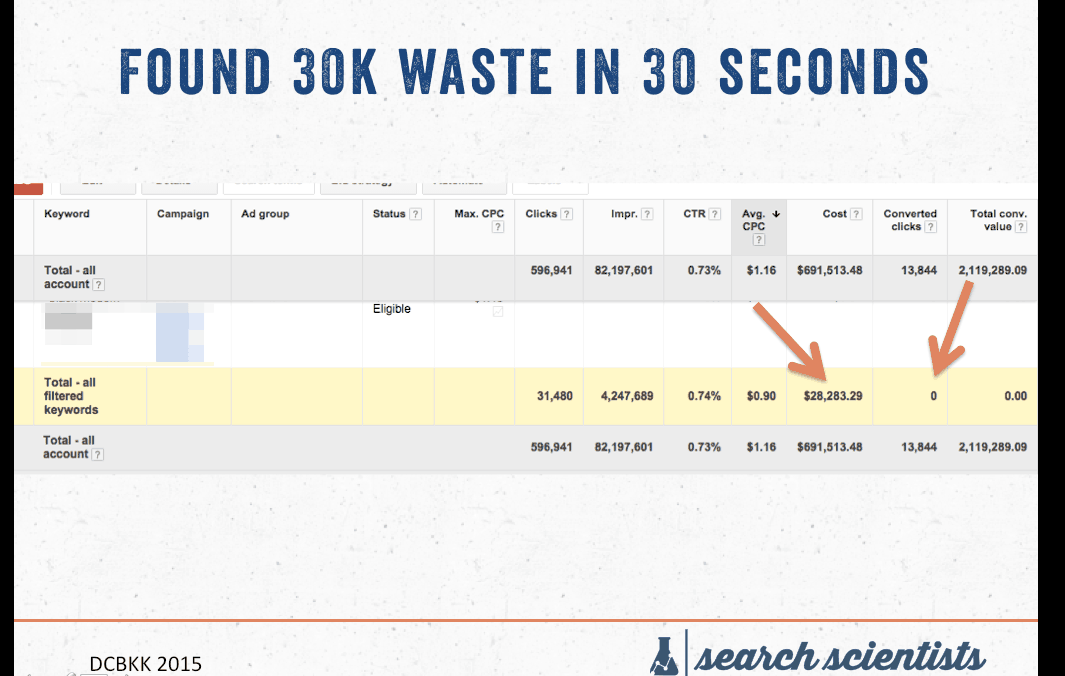
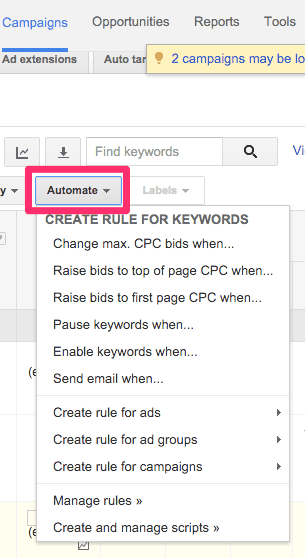
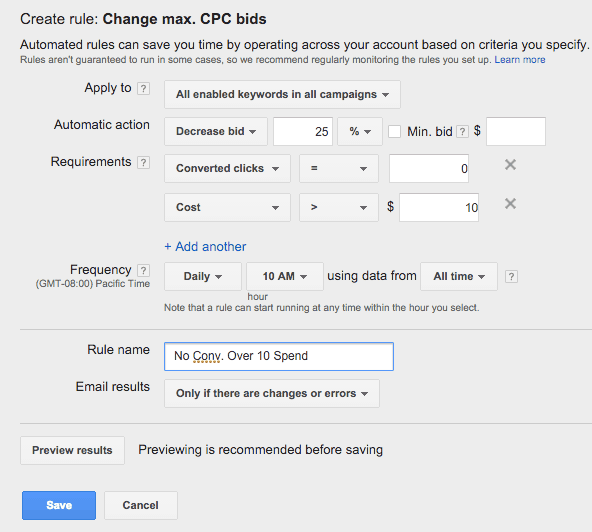
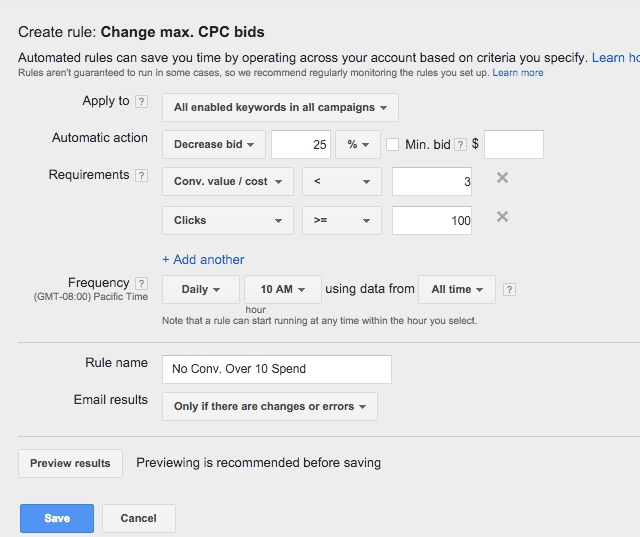


5 thoughts on “The Complete Guide to Avoiding Wasted Spend on Google Ads”
The very end of this post is cut off. But, this post was bad ass and I learned a lot of useful tips. Going to try to implement an anomaly detection alert script, although I’m not sure how useful it will be for my account since it is such low volume at this point.
Yo @disqus_aWOpfXA9BK:disqus thanks for the heads up about this post. Looks like PPC-Monster came and ate the last sentence of this post. Just updated.
Thanks for the kind words – even with a low volume campaign, you can set up some of these rules and keep the campaigns in check from the start!
Thanks for your blog about SEO methods. We are also offering
SEO services and next time I will definitely follow your methods.
http://www.sopro.co.nz/
Hi nice post written by you about SEO freelancer. It is amazing and wonderful to visit your site. Thanks a ton for such a nice post.
http://www.sopro.co.nz/websites.html
if your tired of trying to run your PPC campaigns efficiently as you just don’t have the time the give the experts a call now at rankingsolutions.co.uk. We offer a range of marketing services to increase your ROI.